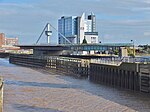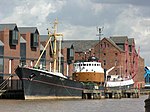River Hull tidal surge barrier

The River Hull tidal surge barrier is a flood control gate located on the River Hull in the city of Kingston upon Hull, in the East Riding of Yorkshire, England. The barrier impounds the river in times of tidal surges, preventing water moving upstream of the river from the Humber Estuary, and flooding the areas of the city which are near to the river, or susceptible to flooding. It is held horizontal when not in use, and turns 90 degrees before being lowered to the riverbed in the event of a tidal surge. It is the second largest flood barrier in the United Kingdom after the Thames Barrier in London. The barrier was opened in 1980, and since then, has closed over 30 times as a preventative measure during tidal surges. A proposed lagoon to control tidal flooding in the Humber Estuary would render the River Hull non-tidal. The barrier was grade II listed in 2017, with David Neave describing it as a prominent Hull landmark.
Excerpt from the Wikipedia article River Hull tidal surge barrier (License: CC BY-SA 3.0, Authors, Images).River Hull tidal surge barrier
Millennium Bridge, Hull Old Town
Geographical coordinates (GPS) Address Nearby Places Show on map
Geographical coordinates (GPS)
| Latitude | Longitude |
|---|---|
| N 53.739 ° | E -0.33 ° |
Address
The Deep Car Park
Millennium Bridge
HU1 1BH Hull, Old Town
England, United Kingdom
Open on Google Maps










